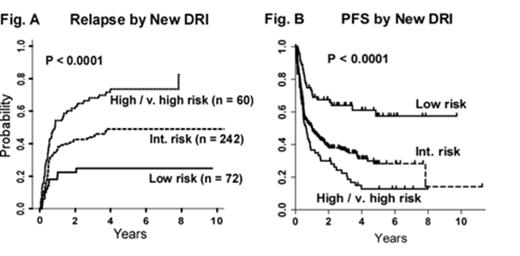Abstract
Background: Recent advances in NMA haplo BMT, including high-dose PTCy for GVHD prophylaxis, have expanded potentially curative treatment options for patients (pts) without a matched donor. The DRI (Blood 2012;120:905), based on disease type and status, was developed to stratify pt risk across histologies and conditioning regimens. The current study evaluated the newly refined DRI (Blood 2014;123:3664) in the largest series of NMA haplo BMT to date.
Methods: We retrospectively analyzed the outcomes of 374 consecutive adult hematologic malignancy pts who received NMA related haplo BMT with PTCy at Johns Hopkins. Eligibility included ECOG PS ≤ 2, LVEF ≥ 35%, adequate pulmonary and renal function and absence of uncontrolled infection. All pts received fludarabine (30 mg/m2IV D -6 to -2), Cy (14.5 mg/kg IV D -6 and -5), TBI (200 cGy D -1) and T-cell replete bone marrow. GVHD prophylaxis consisted of high-dose PTCy (50 mg/kg IV D 3 and 4), mycophenolate mofetil and tacrolimus. Maintenance therapy (e.g., imatinib) after engraftment was permitted. The median age was 55 (range 18-75) at BMT, 132 (35%) pts were aged ≥ 60 and 71 (19%) had prior autologous BMT. Diagnoses were acute leukemia or lymphoblastic lymphoma (115 pts; 31%), MDS or MPN (36 pts; 10%), aggressive NHL (95 pts; 25%), Hodgkin lymphoma (36 pts; 10%), mantle cell lymphoma (29 pts; 8%) and indolent lymphoid cancers (63 pts; 17%). By the new DRI, disease risk was low in 72 pts (19%), intermediate (int) in 242 (65%), high in 50 (13%) and very (v) high in 10 (3%).
Overall results: With a median follow-up of 3.4 (range 0.5-11.4) years (y) in surviving pts, 3-y probabilities of PFS and OS were 40 (95% CI 35-45)% and 50 (45-56)%, respectively. The probability of neutrophil recovery was 89% by D30 (median 17 d). By competing-risk analyses, the D180 probability of nonrelapse mortality (NRM) was 8 (95% CI 5-10)%, grade 2-4 acute GVHD was 32 (27-37)%, and grade 3-4 acute GVHD was 4 (2-6)%. The 2-y probability of chronic GVHD was 13 (10-17)%.
Results by DRI: Among the 3 DRI risk groups (low, int, high/v high), there were no statistically significant differences in histology (lymphoid vs myeloid), HCT-CI risk category, median CD34+ graft dose or pt CMV serostatus. Median pt age was greater in the higher risk groups (P = 0.01). On unadjusted analyses of the new DRI, the probability of relapse by competing-risk differed clearly between the groups (P < 0.0001; Fig. A), with no statistically significant difference in NRM (P = 0.53). This was coupled with statistically significant differences in both PFS and OS. In low, int and high/v high risk groups, 3-y PFS estimates were 64%, 37% and 22%, respectively (P < 0.0001; Fig. B), and 3-y OS estimates were 69%, 49% and 34% (P = 0.0001). Furthermore, on multivariate analyses adjusted for age and year of BMT, the new DRI was independently associated with overall outcomes. Compared to low-risk pts, the HR for relapse was 3.0 (95% CI 1.8-5.2) for int risk pts (P = 0.0001) and 4.7 (2.6-8.5) for high/ v high risk pts (P < 0.0001). HRs for both PFS and OS were ≥ 2-fold greater for int and high/v high risk pts compared to low risk pts (each P ≤ 0.0002). On multivariate analyses, the original DRI (13% low risk, 68% int, 19% high/v high) was also independently associated with relapse, PFS and OS (each P ≤ 0.003). When stratified by DRI, survival outcomes with reduced-intensity, matched related or unrelated BMT (based on 614 pts from the original DRI study cohort; personal communication, P. Armand) and haplo BMT with PTCy appeared similar (Table).
Conclusion: The DRI appears to effectively stratify and prognosticate pts undergoing NMA haplo BMT. When stratified by DRI, the efficacy and survival outcomes with NMA haplo BMT with PTCy appear comparable to those reported with matched BMT. Within this transplant platform, the results support the use of the DRI in outcome analyses and randomized clinical trials involving heterogeneous groups of pts.
| Survival Estimates by DRI | ||||
| 3-y PFS (%) | 3-y OS (%) | |||
| Original DRI | Matched | Haplo | Matched | Haplo |
| Low | 66 | 63 | 70 | 71 |
| Intermediate | 31 | 39 | 47 | 49 |
| High / very high | 15 | 25 | 25 | 38 |
| Survival Estimates by DRI | ||||
| 3-y PFS (%) | 3-y OS (%) | |||
| Original DRI | Matched | Haplo | Matched | Haplo |
| Low | 66 | 63 | 70 | 71 |
| Intermediate | 31 | 39 | 47 | 49 |
| High / very high | 15 | 25 | 25 | 38 |
Off Label Use: High-dose posttransplantation cyclophosphamide.
Author notes
Asterisk with author names denotes non-ASH members.



This feature is available to Subscribers Only
Sign In or Create an Account Close Modal